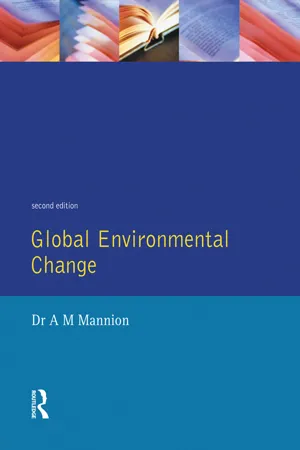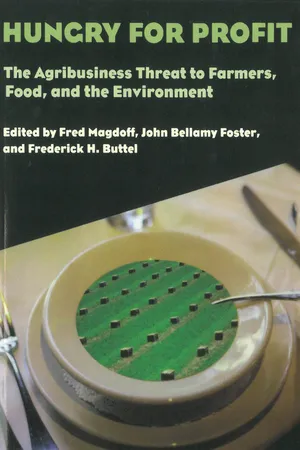Geography
Environmental Impact of Agriculture
The environmental impact of agriculture refers to the effects of farming practices on the natural surroundings. These impacts can include soil erosion, water pollution from agricultural runoff, deforestation for farmland, and greenhouse gas emissions from livestock. Sustainable agricultural practices aim to minimize these negative impacts and promote environmental conservation.
Written by Perlego with AI-assistance
Related key terms
3 Key excerpts on "Environmental Impact of Agriculture"
- eBook - ePub
Global Environmental Change
A Natural and Cultural Environmental History
- Antoinette Mannion(Author)
- 2014(Publication Date)
- Routledge(Publisher)
CHAPTER 8 The Environmental Impact of Agriculture in the developing world 8.1 Introduction Population growth, foreign aid and the desire to earn foreign currency have, in the past 50 years, stimulated the expansion of agriculture in developing nations and have thus prompted environmental change. Although there are many success stories in terms of increased food supply (China can now feed its population of 1.115 billion), the expansion and intensification of agriculture have also brought about environmental degradation. As in the case of the developed world (Chapter 7), the impact of agriculture is manifest in the loss of natural habitats and associated loss of biodiversity. This is affecting all types of natural ecosystems but the loss of tropical forests is of greatest concern because of the impact it is likely to have on global climate and because of the loss of species which might generate useful substances, e.g. pharmaceuticals and agricultural chemicals, in the future. The removal of the natural vegetation cover gives rise to soil erosion and degradation; this may reach such proportions that agricultural systems become unproductive. In situ soil degradation, which causes loss of production, can also occur. However, there are examples of successful soil conservation which demonstrate that land degradation can be reversible and productivity restored. This is also true of desertification, which is more extensive in the developing world than in the developed world. Nevertheless, it is a particularly serious problem in Africa and Asia. Agricultural practices have also had a major impact on water quality in the developing world. For example, cultural eutrophication is becoming increasingly significant as developing countries turn to artificial fertilisers to boost agricultural production - eBook - ePub
Hungry for Profit
The Agribusiness Threat to Farmers, Food, and the Environment
- Fred Magdoff, John Bellamy Foster, Frederick H. Buttel(Authors)
- 2000(Publication Date)
- Monthly Review Press(Publisher)
Chapter FourECOLOGICAL IMPACTS OF INDUSTRIAL AGRICULTURE AND THE POSSIBILITIES FOR TRULY SUSTAINABLE FARMING
MIGUEL A. ALTIERIUntil about four decades ago, crop yields in agricultural systems depended mainly on internal resources, recycling of organic matter, built-in biological control mechanisms, and natural rainfall patterns. Agricultural yields were modest but stable. Production was safeguarded by growing more than one crop or variety in a field as insurance against pest outbreaks or severe weather. Inputs of nitrogen were gained by rotating major field crops with legumes. Growing many different types of crops over the years in the same field also suppressed insects, weeds, and diseases by effectively breaking the life cycles of these pests. A typical corn-belt farmer grew corn rotated with several crops including soybeans as well as the clovers, alfalfa, and small grains needed to maintain livestock. Most of the labor was done by the family with occasional hired help, and no specialized equipment or services were purchased from off-farm sources. In these types of farming systems the link between agriculture and ecology was quite strong and signs of environmental degradation were seldom evident.1The significance of biological diversity in maintaining such systems cannot be overemphasized. Diversity of crops above ground as well as diversity of soil life below ground provided protection against the vagaries of weather, market swings, as well as outbreaks of diseases or insect pests.2 But as agricultural modernization progressed, the ecology-farming linkage was often broken as ecological principles were ignored or overridden. Numerous agricultural scientists agree that modern agriculture confronts an environmental crisis. A growing number of people have become concerned about the long-term sustainability of existing food production systems. Evidence has accumulated showing that, while the present capital- and technology-intensive farming systems have been extremely productive and able to furnish low-cost food, they also bring a variety of economic, environmental, and social problems.3 - eBook - ePub
- Heinrich Wohlmeyer, Theodor Quendler(Authors)
- 2017(Publication Date)
- Routledge(Publisher)
Some of the above-mentioned arguments have already shown implicitly that agriculture produces ‘by-products’ during the production process for which farms are not paid. In economic theory benefits that occur as by-products during the economic production process and that are consumed by the public without rewarding the producer are called ‘positive externalities’. Such effects are not to be found exclusively in agriculture and are therefore not to be seen as an argument for giving this sector a special status. Still, it seems unambiguous and unanimously agreed that in the case of agriculture the extent of the effects and the number of beneficiaries seem to be somewhat remarkable.The relevant questions concerning agricultural production and its contributions to the protection and preservation of the environmental media—soil, water, air and biodiversity—will be dealt with in Chapter 13 . In what follows we deal with two other major benefits: the preservation of the cultural landscape, and risk management.Generally speaking, cultural landscapes are defined as landscapes shaped and maintained by human activity. Agricultural landscapes, which have been shaped by agricultural activity for centuries, constitute a major category of such landscapes. As well as the economic value of food production, the following values are typically derived from such landscapes:- Leisure value (contribution of the landscape to human health and human well-being)
- Aesthetic, cultural and historical values
- Biological and ecological values
These values are sustained by an agricultural production method adapted to the specific landscape and its environmental conditions. They are to be seen as by-products that cannot be decoupled from agricultural activity.Turning to risk management, it is important to recognise that prolonged agricultural production is synonymous with a minimisation of risk. It minimises the risk of food shortage arising from a cut in food imports—something that may become increasingly important in the context of a higher potential incidence of crop failures resulting from climatic change and severe weather events (e.g. floods and hurricanes). It also minimises the risk of losing know-how about agricultural production methods and specifically adapted cultivation techniques over time. Such knowledge, which in many cases is based on working experience, could be regained only in the long run. Its loss threatens food shortages if production, having once stopped, must be abruptly restarted. The risk of food shortage as a result of political unrest or logistical breakdowns tends, today, to be underestimated. The tendency is to centralise the logistics of food-supply operations and to decrease national buffer stocks, which increases national vulnerabilities to any supply problems.
Learn about this page
Index pages curate the most relevant extracts from our library of academic textbooks. They’ve been created using an in-house natural language model (NLM), each adding context and meaning to key research topics.


